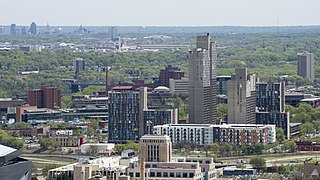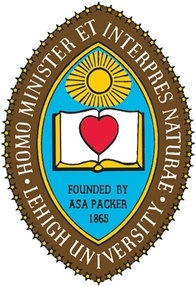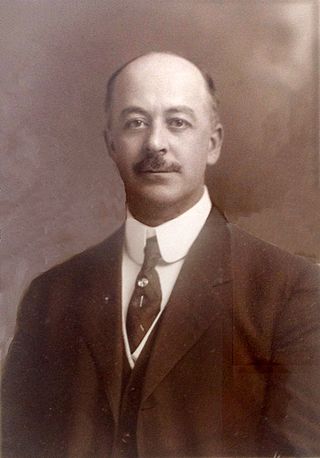
Bethlehem is a city in the Israeli-occupied West Bank of the State of Palestine, located about ten kilometres south of Jerusalem. It is the capital of the Bethlehem Governorate, and as of 2017 had a population of 28,591 people. The city's economy is largely tourist-driven; international tourism peaks around and during Christmas, when Christians embark on a pilgrimage to the Church of the Nativity, revered as the location of the Nativity of Jesus.

Twin cities are a special case of two neighboring cities or urban centres that grow into a single conurbation – or narrowly separated urban areas – over time. There are no formal criteria, but twin cities are generally comparable in status and size, though not necessarily equal; a city and a substantially smaller suburb would not typically qualify, even if they were once separate. Tri-cities and quad cities are similar phenomena involving three or four municipalities.

Lehigh University (LU) is a private research university in Bethlehem, Pennsylvania, in the Lehigh Valley region of eastern Pennsylvania. The university was established in 1865 by businessman Asa Packer and was initially affiliated with the Episcopal Church. Lehigh University's undergraduate programs have been coeducational since the 1971–72 academic year. As of 2019, the university had 5,047 undergraduate students and 1,802 graduate students.

Washington County is a county in the Commonwealth of Pennsylvania, United States. As of the 2020 census, the population was 209,349. Its county seat is Washington. The county is part of the Greater Pittsburgh region of the state.

Northampton County is a county in the Commonwealth of Pennsylvania, United States. As of the 2020 census, the population was 312,951. Its county seat is Easton. The county was formed in 1752 from parts of Bucks County. Its namesake was the county of Northamptonshire in England, and the county seat of Easton was named for Easton Neston, a country house in Northamptonshire.

Allentown is the county seat of Lehigh County, Pennsylvania, United States. It is the third-most populous city in Pennsylvania with a population of 125,845 as of the 2020 census and the most populous city in the Lehigh Valley metropolitan area, which had a population of 861,899 and was the 68th-most populous metropolitan area in the nation as of 2020.

Fountain Hill is a borough in Lehigh County, Pennsylvania, United States. The population of Fountain Hill was 4,832 at the 2020 census, an increase over the figure of 4,597 tabulated in 2010. It is part of the Lehigh Valley metropolitan area, which had a population of 861,899 and was the 68th-most populous metropolitan area in the U.S. as of the 2020 census.

Bethlehem Township is a township in Northampton County, Pennsylvania, United States. The population of Bethlehem Township was 23,730 at the 2010 census. It is a suburb of Bethlehem and is part of the Lehigh Valley metropolitan statistical area, which had a population of 861,899 and was the 68th-most populous metropolitan area in the U.S. as of the 2020 census.

Bethlehem is a city in Northampton and Lehigh Counties in the Lehigh Valley region of eastern Pennsylvania, United States. As of the 2020 census, Bethlehem had a total population of 75,781, making it the second-largest city in the Lehigh Valley after Allentown and the seventh-largest city in the state. Among its total population as of 2020, 55,639 were in Northampton County and 19,343 were in Lehigh County. The city is located along the Lehigh River, a 109-mile-long (175 km) tributary of the Delaware River.

Lehigh Valley International Airport, formerly Allentown–Bethlehem–Easton International Airport, is a domestic airport located in Hanover Township in Lehigh County, Pennsylvania. Lehigh Valley International Airport is located in the center of the Lehigh Valley, roughly 7 miles (11 km) northeast of Allentown, 4 miles (6.4 km) northwest of Bethlehem, and 11 miles (18 km) southwest of Easton.

State Route 1002(SR 1002), locally known as Tilghman Street and Union Boulevard, is a major 13.8 mi (22.2 km) long east–west road in the Lehigh Valley region of eastern Pennsylvania. The majority of the roadway is the former alignment of U.S. Route 22, maintained by the Pennsylvania Department of Transportation as a Quadrant Route, and is not signed except on small white segment markers.
Kenwood was a hamlet in the Town of Bethlehem, New York. The hamlet spanned both sides of the Normans Kill near the area where the Normans Kill flows into the Hudson River. In 1870, and again in 1910, northern portions of Kenwood were annexed by the City of Albany, New York.
Locust Valley was a village located in the southeastern corner of Lehigh County, Pennsylvania, United States. The village is located at the southern end of Upper Saucon Township. It is part of the Lehigh Valley, which has a population of 861,899 and is the 68th-most populous metropolitan area in the U.S. as of the 2020 census.

H. Leh & Co., typically referred to simply as Leh's, was a department store located at 626 West Hamilton Street in Allentown, Pennsylvania. It was of what was an outside mall structure called the Hamilton Mall in the Center City portion of the city. Like many other downtown department stores of the time, however, it ultimately closed as suburban shopping malls gained market share at the expense of inner-city stores.

Robert Heysham Sayre was vice president and chief engineer of the Lehigh Valley Railroad. He was also vice president and general manager of Bethlehem Iron Company, the corporate precursor to Bethlehem Steel. The borough of Sayre, Pennsylvania and the small city of Sayre, Oklahoma were named in his honor.

Archibald Johnston was a mechanical engineer who, favored by Bethlehem Iron Company management and senior Bethlehem Steel Company president Charles M. Schwab, became president of Bethlehem Steel Company. He was subsequently appointed as first vice president of the Bethlehem Steel Corporation in charge of foreign sales. While first vice president, he led a municipal consolidation campaign to create the modern city of Bethlehem, Pennsylvania, from the boroughs of Bethlehem and South Bethlehem.
Shimersville is a former village in Northampton County, Pennsylvania that was the first inhabited settlement in what is now Lower Saucon Township. First settled around 1725 Matthew Riegle and Jacob Sheimer established settlement near the mouth of the Saucon Creek, which became the basis of Shimersville.
Curtis H. "Hank" Barnette is a lawyer, businessman, educator, philanthropist, and chairman emeritus of Bethlehem Steel Corporation.
Altonah was a former village in Northampton County, Pennsylvania located one mile north of the then borders of Bethlehem, Pennsylvania. The village's name is a corruption of the German phrase "all zu nähe", translated as "all too near", referencing its close proximity to Bethlehem and the fact that the village was inhabited by German settlers.
















